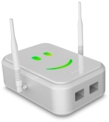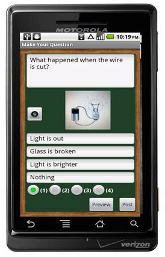Plug Computer takes on education with Marvell SMILE Plug micro server
Jan 11, 2012 — by Eric Brown — from the LinuxDevices Archive — 4 viewsMarvell announced an education platform combining its Plug Computer, Arch Linux, and software developed in collaboration with Stanford University. The SMILE Plug micro server runs on a 2GHz Marvell Armada 300 processor, sets up a secure Wi-Fi cloud for up to 60 students, and provides a “Classroom 3.0” connected, secure, interactive learning environment.
 At CES this week, along with a joint announcement with OLPC of the Marvell Armada PXA618-based XO 3 educational tablet, Marvell announced a second educational platform called the SMILE Plug. Based on Marvell's Plug Computer 3.0 reference design, which uses an Armada 300 processor, the SMILE Plug (pictured at right and farther below) is billed as the first ultra-small server designed specifically for multi-modal curriculum delivery.
At CES this week, along with a joint announcement with OLPC of the Marvell Armada PXA618-based XO 3 educational tablet, Marvell announced a second educational platform called the SMILE Plug. Based on Marvell's Plug Computer 3.0 reference design, which uses an Armada 300 processor, the SMILE Plug (pictured at right and farther below) is billed as the first ultra-small server designed specifically for multi-modal curriculum delivery.
Marvell collaborated with the Stanford Mobile Inquiry Based Learning Environment (SMILE) program to develop the device along with a cloud-based secure learning environment referred to as "Classroom 3.0." The SMILE Plug acts as a Linux-based Wi-Fi access point and server, creating a "micro cloud" within a classroom. The micro-server approach is said to eliminate the problem of inconsistent Internet access within classrooms.
 Marvell notes the Classroom 3.0 environment is completely controlled by the teacher. However, the multi-modal curriculum is also described as highly interactive and student-focused, with an emphasis on critical reasoning and problem solving.
Marvell notes the Classroom 3.0 environment is completely controlled by the teacher. However, the multi-modal curriculum is also described as highly interactive and student-focused, with an emphasis on critical reasoning and problem solving.
No age groups were detailed, although Classroom 3.0 appears to be aimed primarily at K-12 students. The SMILE project video at the end of this story, however, shows the platform at use in a Stanford University classroom. As with OLPC's XO 3, the SMILE Plug is ready for schools in emerging nations as well as more technologically developed countries.
The SMILE plug delivers digital content and receives feedback to and from devices including personal computers and handheld devices, says Marvell. In the video, students devise quizzes on apps running on their smartphones (pictured at above), and then upload them to the server where they are taken by other students. Teachers, meanwhile, can receive real-time analytics on the test process.
The Marvell SMILE Plug is based on the most recent Plug Computer 3.0 SheevaPlug Plug Computer design announced two years ago, which features Marvell's ARMv5 based Armada 300 (88F6282) system on chip (SoC). The SoC has appeared in a variety of network-attached storage (NAS) devices, typically clocked to 1.6GHz. Nevertheless, Marvell has claimed from the beginning the SoC can be clocked to 2GHz, and mentions that clock rate again as the upper limit for the SMILE Plug.

Marvell SMILE Plug showing indicator lights for off, on, and error (left to right)
(Click to enlarge)
The most noticeable feature on the device is indicator lights that light up in a green smile for active operation, a frown to show an error message, and no light at all when the device is turned off (see image above). A 5V Lithium-Ion polymer battery is said to be available for backup power.
The SMILE Plug Computer features an open platform based on Arch Linux. It also ships with Marvell's Plugmin API set and administration app, as well as the Stanford SMILE Junction Server and Classroom 3.0 educational framework, says the company.
Stated Weili Dai, Co-founder of Marvell, "Through our work with organizations like OPLC and Stanford University, we are helping to transform learning from a static one-way activity to an interactive experience brought to life with compelling content, engaging interactive multimedia and numerous new ways to collaborate."
Wei also refers to Marvell's recent announcement that the Marvell Armada 1500 processor will be used in future Google TV products, noting a possible role for Google TV in education.
"It's a matter of time before we leverage the power of Google TV and other smart screens in our daily lives to bring knowledge experts from around the globe to any local classroom," stated Dai.
Stanford's SMILE and Classroom 3.0 demo'd on YouTube
Source: Stanford Mobile Inquiry Based Learning Environment
(Click to play)
The SMILE Plug will be available in the spring, says Marvell. More information may be found at its Plug Computer page, as well as at Stanford's SMILE page. Marvell will be demonstrating its education solutions at the 2012 Consumer Electronics Show (CES) in its booth, No. 30542, located in South Hall 3 on the upper level through Jan. 13.
This article was originally published on LinuxDevices.com and has been donated to the open source community by QuinStreet Inc. Please visit LinuxToday.com for up-to-date news and articles about Linux and open source.